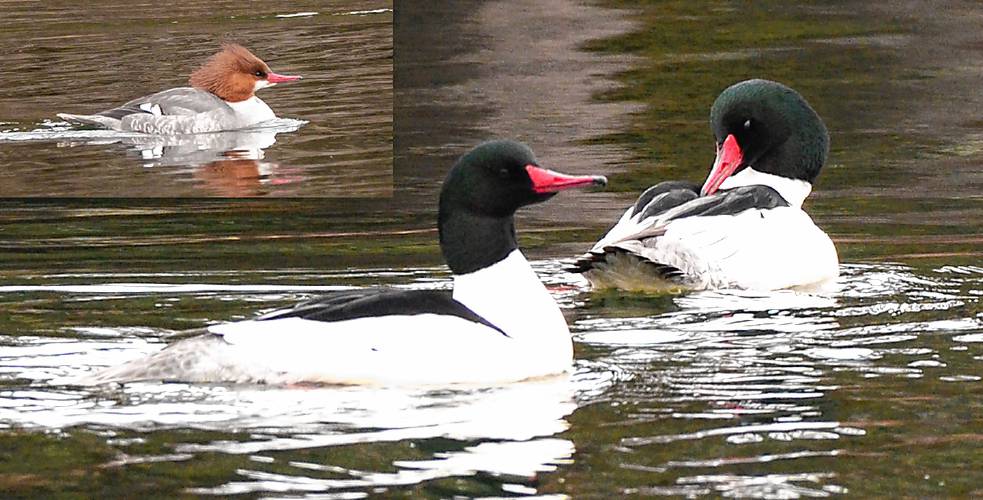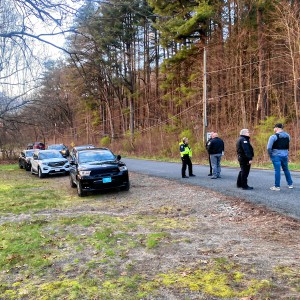Speaking of Nature: One lucky duck: Stumbling upon an entire flotilla of Common Mergansers

Two male common mergansers, below, relax on the pond while I take photos from behind a nearby tree. Note, the subtle green on the tops of their heads. Insert: This female common merganser has quite a different look, but the red bill gives her away. PHOTO BY BILL DANIELSON
| Published: 03-18-2024 5:01 AM |
It was a rainy Sunday morning at the beginning of March and I was suffering from cabin fever. It hasn’t been a particularly cold winter, but I had been cooped up nonetheless. Saturday had gone by without incident, like so many Saturday’s since the new year started and I found myself thinking that I needed a change of scenery before I went crazy.
The fact that it was raining on-and-off was actually a bit of an appeal for this particular morning. There are some ponds in my local five-mile radius and if I might happen to cross paths with some ducks or geese then there might be an opportunity for some beautiful photos. I always look for photos that capture the details of a particular species, but if I can also capture the atmosphere of the day, then I find that I can somehow capture a feeling as well. Rainy days are ideal for this sort of thing.
So, off I went in search of waterfowl. March is always a good month for this sort of search because the ducks and geese are moving north and they are always in search of open water. The problem, I quickly discovered, was that this was not your typical March. The warm temperatures of El Nino have meant that many of the ponds were completely free of ice. This meant that any ducks I crossed paths with would have their pick of where to float, rather than being confined to small patches of open water near the shoreline. Thus, pond after pond proved to be a bust. It was nice to get out and see the world on this beautiful morning, but I hadn’t had any luck.
I was less than a mile from home when my luck changed for the better. At the top of a small hill on my road there lies a sprawling estate that has a walled and gated road. Just on the other side of the gate there is a road that winds its way between two ponds. The smaller pond is situated rather close to the road and the presence of the decorative entrance wall provides a remarkably effective blind for any enterprising photographer such as myself. So it was an amazing stroke of luck when I crested the hill, looked at the pond and saw an entire flotilla of Common Mergansers (Mergus merganser).
No other duck in our area has the same combination of blazing, titanium white body feathers that contrast so starkly with black feathers on the head. However, the astute observer will note that the black head feathers will shine with iridescent green in the right light. The males of this species can be identified from a mile away and I am quite certain that any of my readers who live next to a river or a lake have probably seen these birds many times. They are simply impossible to miss, but on this particular morning I was not going to have to watch them from a distance!
I gently stopped the car, put it in reverse and backed up to the entrance with the wall and the gate. As it so happens, there was also a favorably placed ornamental cedar tree on the opposite side of the wall, which meant that I could exit my car without being seen by the ducks at all. Thinking myself terribly clever I got myself ready, raised my camera and peeked out from behind the tree only to find that the mergansers had moved to the far side of the pond. They were well aware of my presence the whole time, but at least they hadn’t flown away. Now it was about waiting.
With so many individuals on the pond I was eventually able to capture images of both the males and the females. This was important because the sexes look so different from one another. Called “sexual dimorphism,” this is a common characteristic among many animals, but in birds the contrast can be quite dramatic. Female Common Mergansers have pearl-gray bodies with a dazzling cinnamon-colored head that features a feathery crest on the back of the head. Seen alone they might be confused for an entirely different species of duck altogether.
Common Mergansers are fish-eating birds that require large bodies of water with clean, clear water in which to hunt. They are also a surprising species when it comes to nesting because, unlike a Mallard that will build a nest hidden on the ground somewhere, mergansers actually nest up in trees. The females will spend a great deal of time searching for natural cavities up in trees and they will even take up residence in old nest holes excavated by Pileated Woodpeckers.
Article continues after...
Yesterday's Most Read Articles
 Police report details grisly crime scene in Greenfield
Police report details grisly crime scene in Greenfield
 Authorities ID victim in Greenfield slaying
Authorities ID victim in Greenfield slaying
 State records show Northfield EMS chief’s paramedic license suspended over failure to transport infant
State records show Northfield EMS chief’s paramedic license suspended over failure to transport infant
 New buyer of Bernardston’s Windmill Motel looks to resell it, attorney says
New buyer of Bernardston’s Windmill Motel looks to resell it, attorney says
 On The Ridge with Joe Judd: What time should you turkey hunt?
On The Ridge with Joe Judd: What time should you turkey hunt?
 Ethics Commission raps former Leyden police chief, captain for conflict of interest violations
Ethics Commission raps former Leyden police chief, captain for conflict of interest violations
The nest trees need to be within a mile of the water and there have been nests found as high as 100 feet off the ground. This is particularly amazing when you consider the fact that upon hatching from their eggs, the tiny merganser ducklings will have to climb up to the nest entrance and then jump! This will take a bit of cajoling from the mother ducks, but eventually each duckling will leap out into the open air and plummet toward the ground below. The ducklings are so light and fluffy that they actually float a little in the air on their way down and they have particularly flexible bones that allow them to bounce without injury. I would give almost anything to be able to witness this in person and I find myself completely captivated any time that I see the drama played out in a nature documentary.
I will leave you with one final thought. If you happen to be one of those lucky few who lives near water and sees these birds on a daily basis, then you might consider making a nesting box. Plans can easily be found online and it is possible that you might make the life of a female merganser a little easier if the box is located in a good spot. Jumping from a height of 20 feet might also be a much easier way for a family of merganser ducklings to start their little lives.
Bill Danielson has been a professional writer and nature photographer for 26 years. He has worked for the National Park Service, the US Forest Service, the Nature Conservancy and the Massachusetts State Parks and he currently teaches high school biology and physics. For more in formation visit his website at www.speakingofnature.com, or go to Speaking of Nature on Facebook.

 Proof that it’s never too late: Solo exhibit and free workshops honor the late Frederick Gao, a Belchertown resident who became a painter in his last five years
Proof that it’s never too late: Solo exhibit and free workshops honor the late Frederick Gao, a Belchertown resident who became a painter in his last five years Self-expression on display: ServiceNet members’ artworks on view at Greenfield Public Library through end of May
Self-expression on display: ServiceNet members’ artworks on view at Greenfield Public Library through end of May Embracing both new and old: Da Camera Singers celebrates 50 years in the best way they know how
Embracing both new and old: Da Camera Singers celebrates 50 years in the best way they know how Time to celebrate kids and books: Mass Kids Lit Fest offers a wealth of programs in Valley during Children’s Book Week
Time to celebrate kids and books: Mass Kids Lit Fest offers a wealth of programs in Valley during Children’s Book Week
